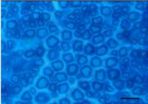(Press-News.org) ATLANTA--Chimpanzees have almost the same personality traits as humans, and they are structured almost identically, according to new work led by researchers at Georgia State University.
The research also shows some of those traits have a neurobiological basis, and that those traits vary according to the biological sex of the individual chimpanzee.
"Our work also demonstrates the promise of using chimpanzee models to investigate the neurobiology of personality processes," said Assistant Professor Robert Latzman of Psychology, who led the research team. "We know that these processes are associated with a variety of emotional health outcomes. We're excited to continue investigating these links."
The team, which also included Professor William Hopkins of Neuroscience, started with a common tool for analyzing chimp personalities called the Chimpanzee Personality Questionnaire.
The questionnaire is filled out by the chimpanzees' caregivers, who rate individual chimps in 43 categories based on their observation of the animals' daily behavior. Is the chimp excitable? Impulsive? Playful? Timid? Dominant? The questionnaire records it all.
The researchers analyzed complete questionnaires for 174 chimpanzees housed at the Yerkes National Primate Center at Emory University. They ran extensive individual analyses to find out which traits tend to go together, and which combine to make more basic, fundamental "meta-traits."
The analysis showed that the most fundamental personality trait for chimpanzees is dominance – that is, whether an animal is a generally dominant and undercontrolled "Alpha," or a more playful and sociable "Beta."
But those two big categories can be broken down statistically into smaller personality traits in ways that echo the personality structures researchers have repeatedly found in child and adult human subjects.
Alpha personalities, for example, statistically break down into tendencies toward dominance and disinhibition. Beta personalities, on the other hand, show low dominance and positive emotionality.
Further analysis shows these lower order traits also can be statistically broken down into their constituent parts. The research team identified five personality factors that combine differently in each individual chimpanzee: conscientiousness, dominance, extraversion, agreeableness and intellect. This echoes a well-known five-factor model of the human personality, although the specific factors are slightly different.
Now, for the neurobiology: many of those chimpanzee traits statistically correlate with the function of a neuropeptide called vasopressin. Chimps who were born with a common variant in the genes that control vasopressin behaved differently than their peers, the males showing more dominance and more disinhibition, but the females less of both.
This research shows not only a neurobiological basis for personality, but an evolutionary basis as well. The neurobiological bases of personality can vary according to the biological sex of the subject, at least in chimpanzees. Chimpanzee personality appears to have almost the same ingredients as human personalities, and that similarity seems to arise from the species' similar neurobiology.
"These results are particularly significant in light of the striking parallels between the major dimensions of personality found between chimpanzees and humans," said Sam Gosling, professor of psychology at the University of Texas at Austin and an internationally known researcher in cross-species personality research.
INFORMATION:
"Personality in Chimpanzees (Pan Troglodytes): Exploring the Hierarchical Structure and Associations with the Vasopressin V1A Receptor Gene," appeared in the April 21 issue of the journal PLOS ONE.
The research was supported by the National Institutes of Health and the National Center for Research Resources.
Chimpanzees show similar personality traits to humans, Georgia State researchers say
2014-05-06
ELSE PRESS RELEASES FROM THIS DATE:
US welfare spending up, but help for the neediest down
2014-05-06
Although the nation is spending more on welfare than ever before, most of that money is going to better-off families rather than the very poorest, a researcher found.
Robert A. Moffitt, the Krieger-Eisenhower Professor of Economics at the Johns Hopkins University, found that the United States has become more generous over time in supporting low-income families, spending 74 percent more in inflation-adjusted dollars on welfare programs in 2007 than in 1975. But for the 2.5 million single parent families with the absolute lowest levels of earnings, aid dropped 35 percent ...
Scientists convert stem cells to eye tissue
2014-05-06
Orlando, Fla. — In two separate studies, scientists have developed methods to convert non-embryonic stem cells into eye cells that could be used to restore sight. The research is being presented at the 2014 Annual Meeting of the Association for Research in Vision and Ophthalmology (ARVO) this week in Orlando.
In the first method, researchers converted cells taken from the front of a patient's eye into stem cells, which were then programmed to become nerve cells found in the back of the eye. The second study involved introducing stem cells to a single growth factor, which ...
New gel-based eye fluid aids post-operative healing
2014-05-06
Orlando, Fla. — In an effort to avoid serious side effects suffered after surgery to repair retinal detachment, vision scientists have developed a new product to help stabilize the eye while it heals. The research is being presented at the 2014 Annual Meeting of the Association for Research in Vision and Ophthalmology (ARVO) this week in Orlando, Fla.
In a recent study, Healaflow® a gel based on one of the most common compounds found in the liquid that fills the eye, was tested in rabbit eyes. After surgery to repair retinal detachment in the rabbits, Healaflow® did ...
First reversible glue bandage could save injured soldiers' vision
2014-05-06
Orlando, Fla. — Scientists have developed the first reversible glue that could be used on the battlefield to treat eye injuries, potentially saving soldiers' vision. The research is being presented at the 2014 Annual Meeting of the Association for Research in Vision and Ophthalmology (ARVO) this week in Orlando, Fla.
When applied to a wounded eye, the adhesive warms up and becomes sticky, sealing the wound and minimizing further damage while the soldier is transported for treatment. Upon arriving at a hospital, doctors can simply apply cool saline solution to the glue, ...
WHI reports $37.1B economic return on combined hormone therapy clinical trial
2014-05-06
SEATTLE – Economic findings were released today on the Women's Health Initiative (WHI), estrogen plus progestin (E+P) trial. The WHI is one of the largest National Institutes of Health-funded studies ever conducted on women. Housed at the Fred Hutchinson Cancer Research Center in Seattle, it is a 15-year, multimillion-dollar study established in 1991, involving more than 160,000 women nationwide, including some 3,500 in Washington.
The overall economic return from the WHI E+P trial indicates that changes in practice stemming from the trial provided a net economic return ...
Novel antioxidant makes old arteries seem young again, CU-Boulder study finds
2014-05-06
An antioxidant that targets specific cell structures—mitochondria—may be able to reverse some of the negative effects of aging on arteries, reducing the risk of heart disease, according to a new study by the University of Colorado Boulder.
When the research team gave old mice—the equivalent of 70- to 80-year-old humans—water containing an antioxidant known as MitoQ for four weeks, their arteries functioned as well as the arteries of mice with an equivalent human age of just 25 to 35 years.
The researchers believe that MitoQ affects the endothelium, a thin layer of cells ...
Cataract surgery decreases risk of falls in older patients
2014-05-06
Orlando, Fla. — New research finds that cataract surgery dramatically decreases the number of falls individuals suffer due to poor vision. The research is being presented at the 2014 Annual Meeting of the Association for Research in Vision and Ophthalmology (ARVO) this week in Orlando, Fla.
In a study of more than 400 Vietnamese patients who were 50-plus years old with cataracts in both eyes, the number of falls patients suffered before and after cataract surgery was monitored. Researchers found a 78% decrease in the risk of falls the year after patients had cataract ...
Simulated model of eye's 3D structure facilitates stem cells transplant
2014-05-06
Orlando, Fla. — Scientists have developed a model that mimics the complex structure of the cornea to enable the transplant of healthy corneal stem cells. The research is being presented at the 2014 Annual Meeting of the Association for Research in Vision and Ophthalmology (ARVO) this week in Orlando Fla.
Used to restore sight, corneal stem cells live in a specific physical environment. Transplanting these stem cells requires accurate mimicry of their natural surroundings during transport. In this work, vision scientists have recreated the 3D architecture where corneal ...
Astronomers harness the galaxy's biggest telescope
2014-05-06
An international team of astronomers has made a measurement of a distant neutron star that is one million times more precise than the previous world's best.
The researchers were able to use the interstellar medium, the 'empty' space between stars and galaxies that is made up of sparsely spread charged particles, as a giant lens to magnify and look closely at the radio wave emission from a small rotating neutron star.
This technique yielded the highest resolution measurement ever achieved, equivalent to being able to see the double-helix structure of our genes from the ...
A novel transgenic mouse model of Chinese Charcot-Marie-Tooth disease type 2L
2014-05-06
Dr. Ruxu Zhang and colleagues from Third Xiangya Hospital, Central South University in China previously found that the K141N mutation in heat shock protein B8 (HSPB8) was responsible for Charcot-Marie-Tooth disease type 2L in a large Chinese family. Therefore, they generated a transgenic mouse model bearing the K141N mutation in the human HSPB8 gene, and to determine whether this K141NHSPB8 transgenic mouse model would manifest the clinical phenotype of Charcot-Marie-Tooth disease type 2L, and consequently be suitable for use in studies of disease pathogenesis. The K141NHSPB8 ...

